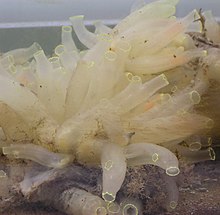Ciona intestinalis
| Vase tunicate | |
|---|---|
 |
|
| Ciona intestinalis | |
| Scientific classification | |
| Kingdom: | Animalia |
| Phylum: | Chordata |
| Subphylum: | Tunicata |
| Class: | Ascidiacea |
| Order: | Enterogona |
| Suborder: | Phlebobranchia |
| Family: | Cionidae |
| Genus: | Ciona |
| Species: | C. intestinalis |
| Binomial name | |
|
Ciona intestinalis (Linnaeus, 1767) |
|
Ciona intestinalis (sometimes known by the common name of vase tunicate) is an ascidian (sea squirt), a tunicate with very soft tunic. Its Latin name means, literally, "pillar of intestines", referring to the fact that its body is a soft, translucent column-like structure, resembling a mass of intestines sprouting from a rock. It is a globally distributed cosmopolitan species. Since Linnaeus described the species, Ciona intestinalis has been used as a model invertebrate chordate in developmental biology and genomics. Recent studies have shown that there are at least two, possibly four, sister species. By anthropogenic means, the species has invaded various parts of the world and is known as an invasive species.
Although Linnaeus first categorised this species as a kind of mollusk, Alexander Kovalevsky found a tadpole-like larval stage during development that shows similarity to vertebrates. Recent molecular phylogenetic studies as well as phylogenomic studies support that sea squirts are the closest invertebrate relatives of vertebrates. Its full genome has been sequenced using a specimen from Half Moon Bay in California, USA, showing a very small genome size, less than 1/20 of the human genome, but having almost full sets of genes sharing almost all sets of genes but one copy for almost all genes.
Ciona intestinalis is a solitary tunicate with a cylindrical, soft, gelatinous body, up to 20 cm long. The body colour and colour at the distal end of siphons are major external characters distinguishing sister species within the species complex.
The body of Ciona is bag-like and covered by a tunic, which is a secretion of the epidermal cells. The body is attached by a permanent base located at the posterior end, while the opposite extremity has two openings, the buccal and atrial siphons. Water is drawn into the ascidian through the buccal (oral) siphon and leaves the atrium through the atrial siphon (cloacal).
Ciona intestinalis is a hermaphroditic broadcast spawner but cannot self-fertilize. Eggs and sperm, when released, can stay in the water column for 1 to 2 days while the larvae are free-swimming for 2 to 10 days.
Ciona intestinalis is considered to be an invasive species and grows in dense aggregations on any floating or submerged substrate, particularly artificial structures like pilings, aquaculture gear, floats and boat hulls, in the lower intertidal to sub-tidal zones. It often grows with or on other fouling organisms. It is thought to spread to new areas mainly through hull fouling. Since its larvae can live for up to 10 days, this species may also be transferred through the release of bilge or ballast water.
...
Wikipedia
